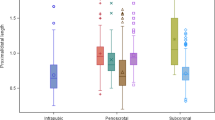Abstract
Inflatable penile prostheses (IPPs) are widely accepted as a means of surgical treatment of erectile dysfunction. It has been suggested that surgeon volume influences patient outcomes after IPP implantation. We used a written questionnaire to ask urologists who perform IPP surgery about their practice patterns. Our analysis correlated specific practices to self-reported IPP volume. A written questionnaire was distributed to 1968 urologists. Responses were collated and analyzed. Respondents were defined as high volume implanters (HVIs) if they placed ⩾20 IPPs in the year preceding the survey, or low volume implanters (LVIs) if they placed ⩽19. Our main outcome measures were surgeon volume, approach to initial IPP placement (penoscrotal vs infrapubic), strategy for reservoir management during IPP revision surgery, strategy for reservoir replacement when deemed necessary, approach to suspected IPP infections, and utilization of revision washout protocols. This study does not require institutional review board approval from our institution, given that patient information is not used at all, this is a practitioner survey only. HVIs were significantly more likely to incorporate both penoscrotal and suprapubic approaches into their armamentarium, more likely to manipulate previously placed IPP reservoirs during revision surgery, and more likely to operate immediately when confronted with a suspected IPP infection. They were also more likely than LVIs to use the Mulcahy revision washout protocol. There are significant differences in the self-reported practice patterns of HVIs and LVIs. The importance of these differences for patient outcomes remains undefined.
This is a preview of subscription content, access via your institution
Access options
Subscribe to this journal
Receive 8 print issues and online access
$259.00 per year
only $32.38 per issue
Buy this article
- Purchase on Springer Link
- Instant access to full article PDF
Prices may be subject to local taxes which are calculated during checkout





Similar content being viewed by others
References
Hellstrom WJ, Montague DK, Moncada I, Carson C, Minhas S, Faria G . Krishnamurti SImplants mechanical devices, vascular surgery for erectile dysfunction. J Sex Med 2010; 7 (1 pt 2): 501.
Wilson SK, Delk JR, Salem EA, Cleves MA . Long-term survival of inflatable penile prostheses: single surgical group experience with 2384 first-time implants spanning two decades. J Sex Med 2007; 4: 1074–1079.
Carson CC . Diagnosis, treatment, prevention of penile prosthesis infection. Int J Impot Res 2003; 15 (Suppl 5): S139–S146.
Lotan Y, Roehrborn CG, McConnell JD, Hendin BN . Factors influencing the outcomes of penile prosthesis surgery at a teaching institution. Urology 2003; 65: 918–921.
Henry GD, Kansal NS, Callaway M, Grigsby T, Henderson J, Noble J et al. Centers of excellence concept penile prostheses: an outcome analysis. J Urol 2009; 181: 1264–1268.
Althof SE, Buvat J, Gutkin SW, Belger M, Stothard DR, Fugl-Meyer AR . Sexual satisfaction in men with erectile dysfunction: correlates, potential predictors. J Sex Med 2009; 7 (1 Pt 1): 203–215.
Brody S, Costa RM . Satisfaction (sexual life, relationship, and mental health) is associated directly with penile-vaginal intercourse but inversely with other sexual behavior frequencies. J Sex Med 2009; 6: 1947–1954.
Henry GD . Historical review of penile prosthesis design and surgical techniques: part 1 of a three-part review series on penile prosthetic surgery. J Sex Med 2009; 6: 675–681.
Brant MD, Ludlow JK, Mulcahy JJ . The prosthesis salvage operation: immediate replacement of the infected penile prosthesis. J Urol 1996; 155: 155–157.
Wilt TJ, Shamliyan TA, Taylor BC, MacDonald R, Kane RL . Association between hospital surgeon radical prostatectomy volume patient outcomes: a systematic review. J Urol 2008; 180: 820–828.
Savage CJ, Vickers AJ . Low annual caseloads of United States surgeons conducting radical prostatectomy. J Urol 2009; 182: 2677–2681.
Garber BB, Marcus SM . Does surgical approach affect the incidence of inflatable penile prosthesis infection? Urology 1998; 52: 291–293.
Montague DK, Angermeier KW . Surgical approaches for penile prosthesis infection: penoscrotal vsinfrapubic. Int J Impotence Res 2003; 15 (Suppl 5): S134–S135.
Kramer AC, Chason J . Residents at the University of Maryland Medical System provide insight to learning infrapubic approach for IPP surgery: relative benefits but novel challenges exposed in first 15 cases. J Sex Med 2009; 7: 1298–1305.
Park JK, Jang SW, Lee SW, Cui Y . Rare complication of multiple revision surgeries of penile prosthesis. J Sex Med 2005; 2: 735–736.
Rajpurkar A, Bianco FF, Al-Omar O, Terlecki R, Dhabuwala C . Fate of the retained reservoir after replacement of 3-piece penile prosthesis. J Urol 2004; 172: 664–666.
Kramer AC, Chason J, Kusakabe A . Report of two cases of bladder perforation caused by reservoir of inflatable penile prosthesis. J Sex Med 2009; 6: 2064–2067.
Jiann BP, Ou CW, Lin JT, Hunag JK . Compression of ureter caused by a retained reservoir of penile prosthesis. Int J Impot Res 2006; 18: 316–317.
Derouet H, Uder M, Freyfogle E, Stoeckle M . Successful conservative treatment of infected penile prostheses. Eur Urol 2002; 41: 66–70.
Mulcahy JJ . Long-term experience with salvage of infected penile implants. J Urol 2000; 163: 481–482.
Wilson SK, Delk JR, Mulcahy JJ, Cleves M, Salem EA . Upsizing of inflatable penile implant cylinders in patients with corporal fibrosis. J Sex Med 2006; 3: 736–742.
Author information
Authors and Affiliations
Corresponding author
Ethics declarations
Competing interests
The authors declare no conflict of interest.
Additional information
Supplementary Information accompanies the paper on International Journal of Impotence Research website
Supplementary information
Rights and permissions
About this article
Cite this article
Kramer, A., Sausville, J. & Schweber, A. Practice patterns of urologists performing penile prosthesis surgery vary based on surgeon volume: results of a practice pattern survey. Int J Impot Res 22, 262–266 (2010). https://doi.org/10.1038/ijir.2010.13
Received:
Revised:
Accepted:
Published:
Issue Date:
DOI: https://doi.org/10.1038/ijir.2010.13
Keywords
This article is cited by
-
Perioperative outcomes of penile prosthesis implantation in Germany: results from the GRAND study
International Journal of Impotence Research (2023)
-
Long-term outcomes after penile prosthesis placement for the Management of Erectile Dysfunction: a single-Centre experience
Basic and Clinical Andrology (2021)
-
Infrapubic approach for placement of inflatable penile prosthesis: contemporary review of technique and implications
International Journal of Impotence Research (2020)



